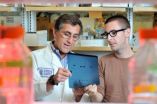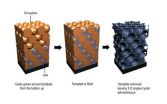(Press-News.org) CORVALLIS, Ore. – The Northwest Forest Plan enacted in 1993 was designed to conserve old-growth forests and protect species such as the northern spotted owl, but researchers conclude in a new study that it had another powerful and unintended consequence – increased carbon sequestration on public lands.
When forest harvest levels fell 82 percent on public forest lands in the years after passage of this act, they became a significant carbon "sink" for the first time in decades, absorbing much more carbon from the atmosphere than they released. At the same time, private forest lands became close to carbon neutral.
Carbon emission or sequestration is a key factor in global warming, and a concept now gaining wider interest is the role of forest lands in helping to address concerns about the greenhouse effect.
Researchers at Oregon State University and the Pacific Northwest Research Station of the USDA Forest Service created these assessments with a new system that incorporates satellite remote sensing and more accurately simulates ecological processes over broad areas. It considers such factors as the growth of trees, decomposition, fire emissions, climate variation and wood harvest.
"The original goals of the Northwest Forest Plan had nothing to do with the issue of carbon emissions, but now carbon sequestration is seen as an important ecosystem service," said David Turner, a professor in the OSU Department of Forest Ecosystems and Society.
"Forests provide many services, such as habitat protection, recreation, water purification, and wood production," he said. "Carbon sequestration has now been added to that list. And our approach can provide the kind of spatially and temporally explicit data that will help evaluate the potential trade-offs associated with management activities."
Previous estimates of forest carbon balance had suggested a significant loss of carbon from Pacific Northwest forest lands between 1953 and 1987, associated with a high rate of old-growth timber harvest. Those harvests peaked in the mid-to-late 1980s.
Forest fire is also an issue in carbon emissions, but researchers said in the study that the magnitude of emissions linked to fire was modest, compared to the impacts of logging. Even the massive Biscuit Fire in southern Oregon in 2002 released less carbon into the atmosphere than logging-related emissions that year, they said.
The findings are of some interest, researchers said, because the value of carbon sequestration is now something that can be better quantified in economic terms, and then incorporated into management decisions and policies.
This study was just published online in Forest Ecology and Management, a professional journal. The research was supported by the U.S. Department of Energy and the interagency North American Carbon Program. The area analyzed included western Oregon, western Washington and northern California.
In earlier work, Turner and other researchers had found that carbon sequestration in Oregon, much of it from forests, amounted to almost half of the state-level carbon emissions from fossil fuel combustion. Nationally, forest carbon accumulation offsets about 15 percent of U.S. fossil fuel emissions.
###
Editor's Note: A graphic image of lands affected by the Northwest Forest Plan is available online: http://bit.ly/qCa1CP
The study this story is based on is available online: http://bit.ly/oxld5b
Northwest Forest Plan has unintended benefit – carbon sequestration
2011-07-25
ELSE PRESS RELEASES FROM THIS DATE:
New target found for nitric oxide's attack on salmonella bacteria
2011-07-25
A new target for nitric oxide has been revealed in studies of how it inhibits the growth of Salmonella. This bacterium is a common cause of food-poisoning.
"Nitric oxide is naturally produced in the nose and the gut and other tissues in the body to ward off infection," explained the senior author of the paper, Dr. Ferric Fang. He is a University of Washington (UW) professor of laboratory medicine, microbiology and medicine.
Nitric oxide – not to be confused with nitrous oxide, the laughing gas in dentists' offices – is similar to the preservatives in hotdogs, Fang ...
2 genetic variations predict second cancers after radiation for children with Hodgkin lymphoma
2011-07-25
A genome-wide association study published in the August issue of Nature Medicine has found two tiny genetic variations that can predict which patients with Hodgkin's lymphoma are most likely to develop radiation-induced second cancers years after treatment. Knowing in advance who is at risk could help physicians tailor treatment to reduce the risks for patients who are most susceptible to long-term damage.
Hodgkin's lymphoma is one of the most treatable cancers, with more than 90 percent of patients surviving after a combination of radiation and chemotherapy. But nearly ...
Graphene's 'quantum leap' takes electronics a step closer
2011-07-25
Writing in the journal Nature Physics, the academics, who discovered the world's thinnest material at The University of Manchester in 2004, have revealed more about its electronic properties.
Research institutes and universities around the world are already looking at ways to build devices such as touch-screens, ultrafast transistors and photodetectors.
Now the research from the creators of the material promises to accelerate that research, and potentially open up countless more electronic opportunities.
The researchers, from the universities of Manchester, Madrid ...
Pocket chemistry: DNA helps glucose meters measure more than sugar
2011-07-25
CHAMPAIGN, Ill. — Glucose meters aren't just for diabetics anymore. Thanks to University of Illinois chemists, they can be used as simple, portable, inexpensive meters for a number of target molecules in blood, serum, water or food.
Chemistry professor Yi Lu and postdoctoral researcher Yu Xiang published their findings in the journal Nature Chemistry.
"The advantages of our method are high portability, low cost, wide availability and quantitative detection of a broad range of targets in medical diagnostics and environmental monitoring," Lu said. "Anyone could use it ...
New photonic crystals have both electronic and optical properties
2011-07-25
CHAMPAIGN, Ill. — In an advance that could open new avenues for solar cells, lasers, metamaterials and more, researchers at the University of Illinois have demonstrated the first optoelectronically active 3-D photonic crystal.
"We've discovered a way to change the three-dimensional structure of a well-established semiconductor material to enable new optical properties while maintaining its very attractive electrical properties," said Paul Braun, a professor of materials science and engineering and of chemistry who led the research effort.
The team published its advance ...
Epigenetic 'memory' key to nature versus nurture
2011-07-25
Researchers funded by the Biotechnology and Biological Sciences Research Council (BBSRC) at the John Innes Centre have made a discovery, reported this evening (24 July) in Nature, that explains how an organism can create a biological memory of some variable condition, such as quality of nutrition or temperature. The discovery explains the mechanism of this memory – a sort of biological switch – and how it can also be inherited by offspring.
The work was led by Professor Martin Howard and Professor Caroline Dean at the John Innes Centre, which receives strategic funding ...
Soft spheres settle in somewhat surprising structure
2011-07-25
Latex paints and drug suspensions such as insulin or amoxicillin that do not need to be shaken or stirred may be possible thanks to a new understanding of how particles separate in liquids, according to Penn State chemical engineers, who have developed a method for predicting the way colloidal components separate based on energy.
"The ongoing assumption was that if you have a mixture of different sized particles in a liquid, the faster-settling particles will end up on the bottom," said Darrell Velegol, professor of chemical engineering. "We found that in many cases it ...
Mismatch between cancer genetics counseling and testing guidelines and physician practices
2011-07-25
A new analysis has found that many doctors report that they do not appropriately offer breast and ovarian cancer counseling and testing services to their female patients. Published early online in CANCER, a peer-reviewed journal of the American Cancer Society, the study indicates that efforts are needed to encourage these services for high-risk women and discourage them for average-risk women.
Women with mutations in the BRCA1 or BRCA2 gene have a substantially increased risk of developing breast and ovarian cancer, but there are medical treatments that can dramatically ...
Children eating more, and more frequently outside the home
2011-07-25
Philadelphia, PA, July 25, 2011 – As childhood obesity rises and the American diet shifts towards increasing consumption of foods eaten or prepared outside of the home, concerns about the nutritional quality and the total consumption of such foods are also increasing. According to a study conducted at the University of North Carolina at Chapel Hill and published in the August 2011 issue of the Journal of the American Dietetic Association, eating location and food source significantly impact daily energy intake for children. Foods prepared away from home, including fast ...
Catching the West Nile virus in action
2011-07-25
Tel Aviv — Since 1999, several outbreaks of West Nile Virus, which causes fever or severe neurological symptoms and is transmitted from birds to humans by blood-sucking mosquitoes, have been seen in the U.S., usually during the summer months. But researchers aren't certain how the virus migrated here — and they don't know how, or where, it will appear next.
Now Prof. Ella Mendelson of Tel Aviv University's School of Public Health at the Sackler Faculty of Medicine, working with the Israeli Ministries of Health and Environment, has instituted a study that tracks both clinical ...




